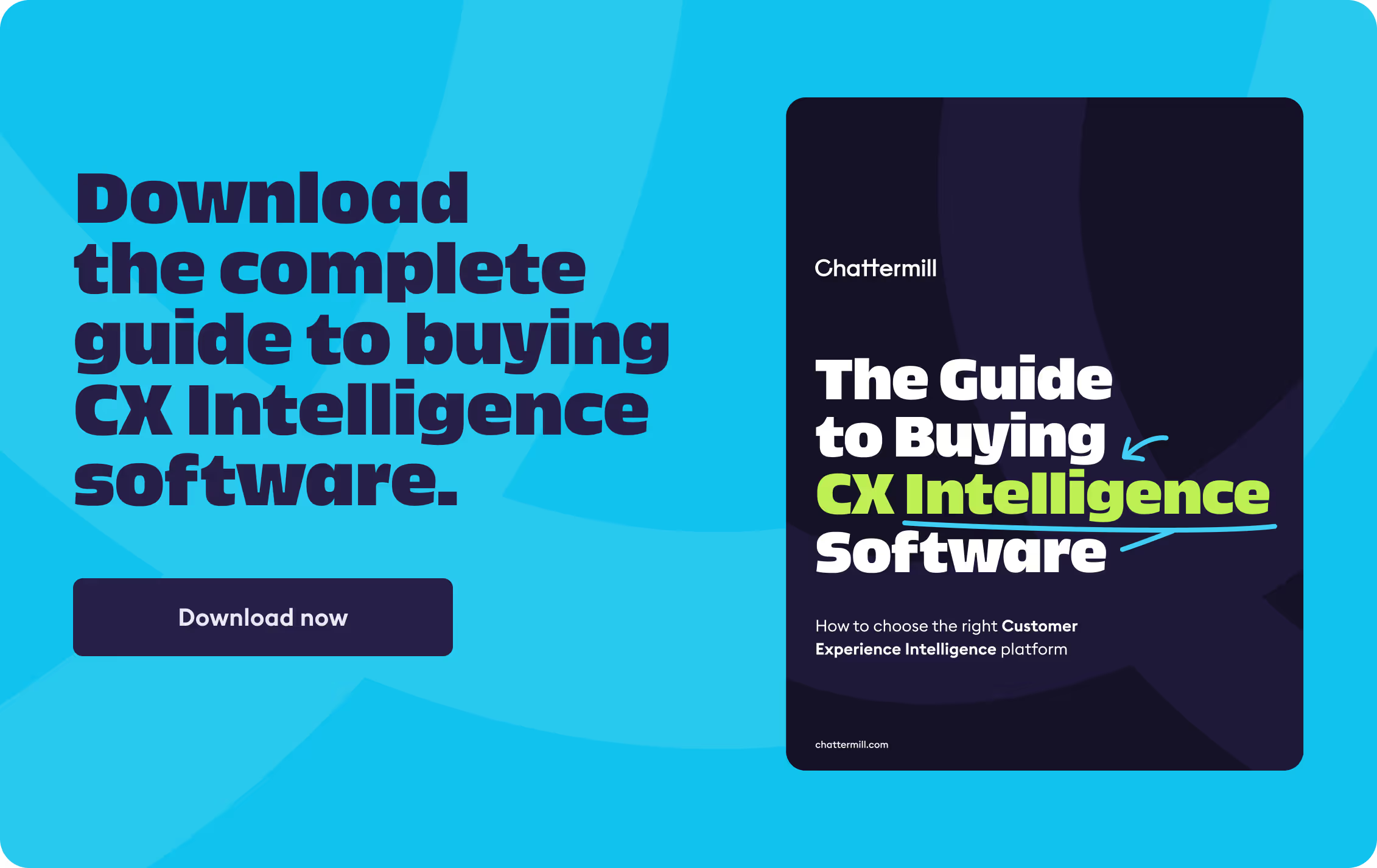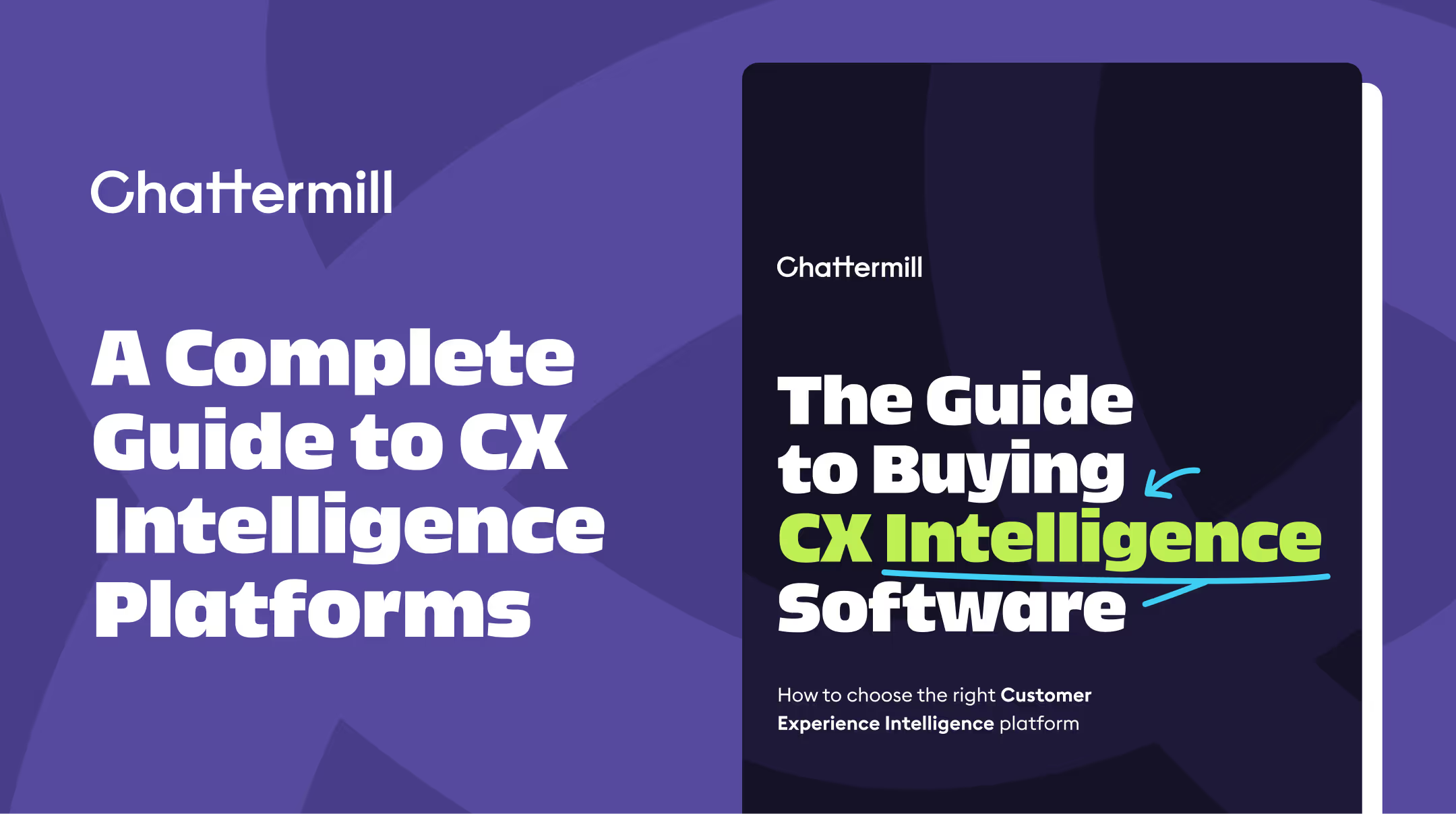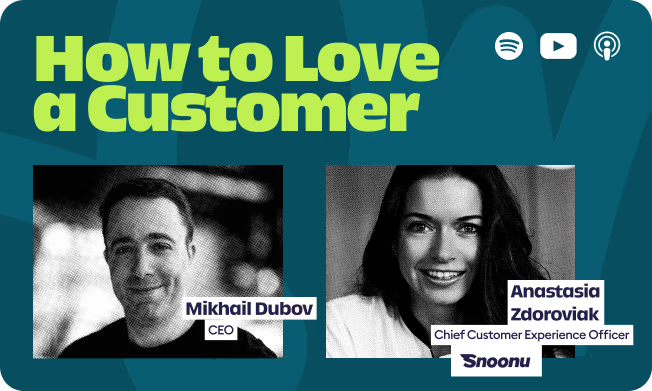Introduction
Customer Experience Intelligence (CXI) is an emerging and exciting software category that will certainly change the way companies drive growth. But you may wonder, “What exactly is it? How is it going to help my business?”
As a leader in this space, Chattermill has long partnered with companies focused on Experience-Led Growth - a strategy emphasizing cultivating exceptional customer experiences as the foundation for sustainable business growth. It's no secret that experience-led companies achieve over double the growth of their industry counterparts.1 Iconic brands like Apple, Amazon, and Uber have mastered the art of transforming customer interactions into memorable experiences, creating passionate fans, and driving revenue.
However, becoming an experience-led company requires significant effort, hard work, and determination. Many businesses often lack the technology, data, and analytics needed to uncover customer needs, design effective solutions, and deliver impactful results. That’s where Customer Experience Intelligence comes in. It bridges the gap between your customer data and the crucial decisions your teams need to make daily to achieve your business objectives.
This guide aims to help you understand Customer Experience Intelligence (CXI) in greater detail, explore why it’s gaining traction among the most customer-centric companies, and identify what to look for when choosing a CXI platform like Chattermill. We hope it will assist you in selecting the right solution, building a strong business case, and aligning your internal teams on your own journey toward becoming an experience-led business.

1 Source: McKinsey, Experience-led growth, a new way to create value

Chapter 1: What is CX Intelligence?
Imagine a world where every business decision is driven by reliable and solid data. Where every team and department has clear answers to any business question and knows exactly what to prioritize to drive meaningful results. All customer concerns, frustrations, or ideas are analyzed in real-time, guiding every decision in business strategy.
That’s exactly what Customer Experience Intelligence was designed for. CX Intelligence goes beyond just showing what customers say. It helps businesses understand why it matters, what’s behind the feedback, and what steps to take next. It’s not just another dashboard - it’s a system designed to link customer input to real actions and business outcomes.

Customer Experience Intelligence is one of the most impactful investments you can make for your business. The insights from a CX Intelligence platform will not only transform how you retain customers but also transform how you make strategic decisions regarding your product offerings, pricing policy, supply chain management, operations, and more.

How do CX Intelligence platforms work?
Implementing CX Intelligence doesn't mean ripping out everything you have in place and starting again. It’s about integrating with your existing ecosystem to enhance and amplify the work you’re already doing.
CXI integrates with your current ecosystem to uncover hidden insights, connect the dots across feedback channels, and help your teams take action with confidence.
Here's what that look like in practice:

Step 1: Listen to all customer feedback
A CX Intelligence platform brings together all your customer experience data - from surveys, reviews, support conversations, and social media - into one unified view. By connecting multiple sources, it eliminates data silos and blind spots, ensuring your teams work from the same, complete view of the customer experience.
Step 2: Understand what’s happening and why
CX Intelligence platforms use advanced AI to analyze customer feedback, uncover trends, and highlight the key factors influencing customer behavior. This helps you move beyond surface-level insights to understand what’s driving your most important business outcomes. By pinpointing the most common pain points and areas for improvement, you can focus your efforts where they’re most likely to impact revenue, retention, and satisfaction.
Step 3: Act with clarity and confidence
Armed with meaningful, data-backed insights, teams across CX, Support, Product, and Revenue can align on priorities and take action where it matters most. Whether it’s improving product quality, reducing returns, strengthening customer relationships, or increasing retention, every decision is guided by a clear understanding of what will drive real business impact.
Customer Experience Intelligence helps teams see the full picture and make truly informed decisions. It connects customer insights to business outcomes, so you can focus efforts where they’ll make a real difference.
Who is CXI for?
Companies from various industries, go-to-market models, target audiences, and stages utilize Customer Experience Intelligence (CXI) to enhance customer experiences, which is crucial for their business growth.
While large B2C companies, such as Amazon, Uber or Booking.com, commonly use CXI solutions, they are increasingly becoming essential for businesses across all sectors. Examples include:
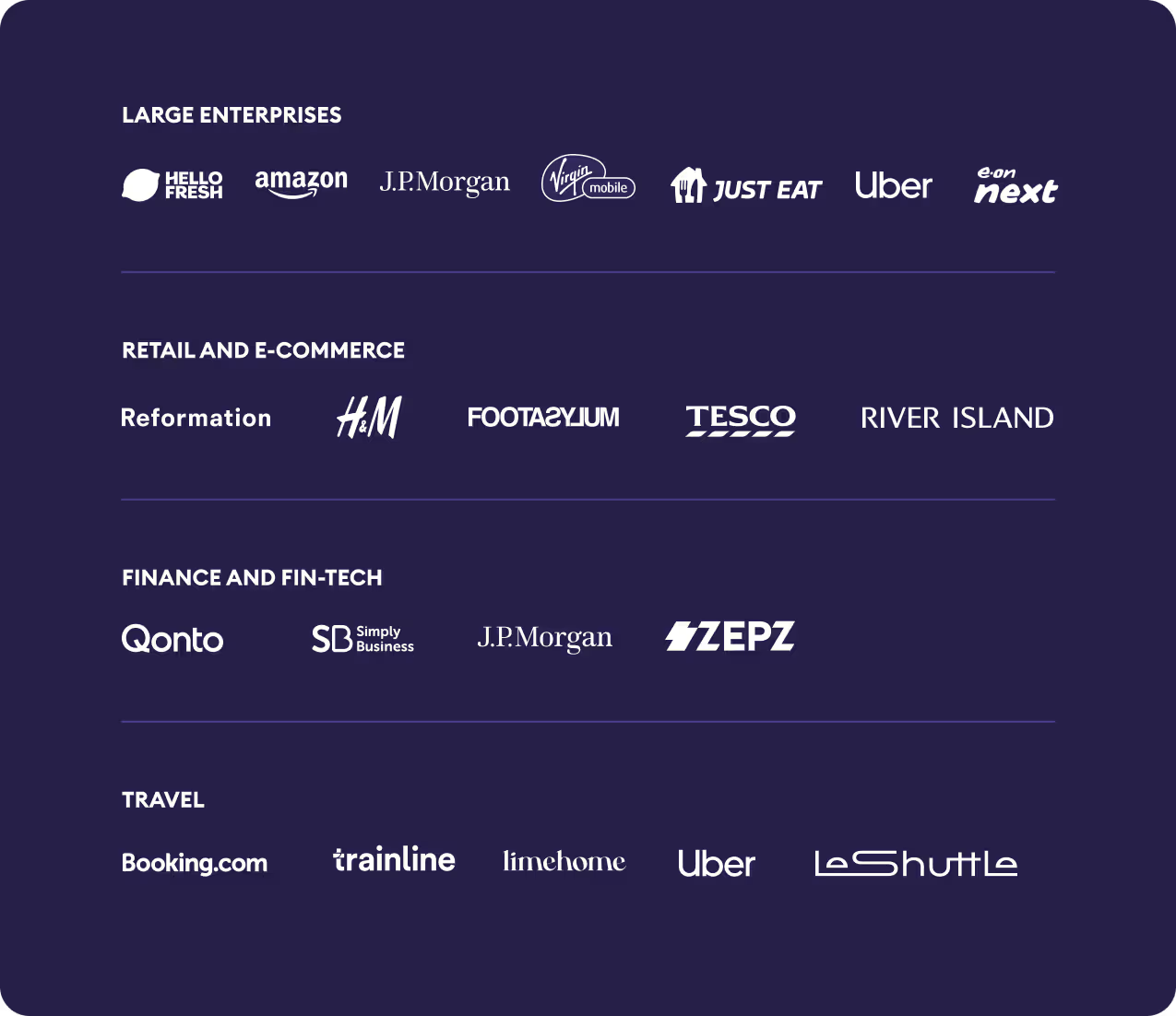
Customer Experience Intelligence (CXI) solutions aren’t designed just for one team - they are utilized by various departments throughout the organization to address their key business challenges. These include:
- CX and Customer Insights teams focused on enhancing customer experiences and improving metrics like NPS, retention, and customer satisfaction.
- Product teams looking to use customer insights to guide product development, drive product adoption, and improve conversion rates at each stage of the customer journey.
- Customer Support teams focused on identifying the most common reasons for customer contacts and reducing time spent on manual analysis.
- Operational teams concentrating on streamlining processes and cutting operational costs to improve overall efficiency.
- Marketing teams using customer insights to create targeted campaigns, personalize messaging, and improve customer acquisition and engagement across channels.
- Revenue teams focused on driving customer loyalty, generating advocacy, and staying competitive by understanding the market landscape.
- Founders and executive teams aiming to improve core business performance by delivering better customer experiences, leading to higher lifetime value (LTV) and long-term sustainable growth.
Most common use cases for CX Intelligence
CXI tools can be widely adopted by different teams and departments for various purposes, aligning everyone across the business around the same goals and objectives.
Here's a look at how CXI platforms can be leveraged for a range of use cases, empowering different functions to achieve business results.
Voice of the Customer Analysis
HOW IT WORKS
Most companies track metrics like NPS or CSAT, but few truly understand what’s driving those scores. A CXI platform can provide insights into how these metrics change over time and, more importantly, why. This helps businesses pinpoint specific factors affecting their scores and prioritize high-impact improvements.
QUESTIONS CXI CAN ANSWER
- Why has NPS or CSAT decreased since last month?
- What customer complaints are driving CX metrics up/down?
- Which CX initiatives will have the highest impact on NPS or CSAT?
BEST FOR
CX, Customer Support, Product, Customer Insights Teams, Marketing, UX
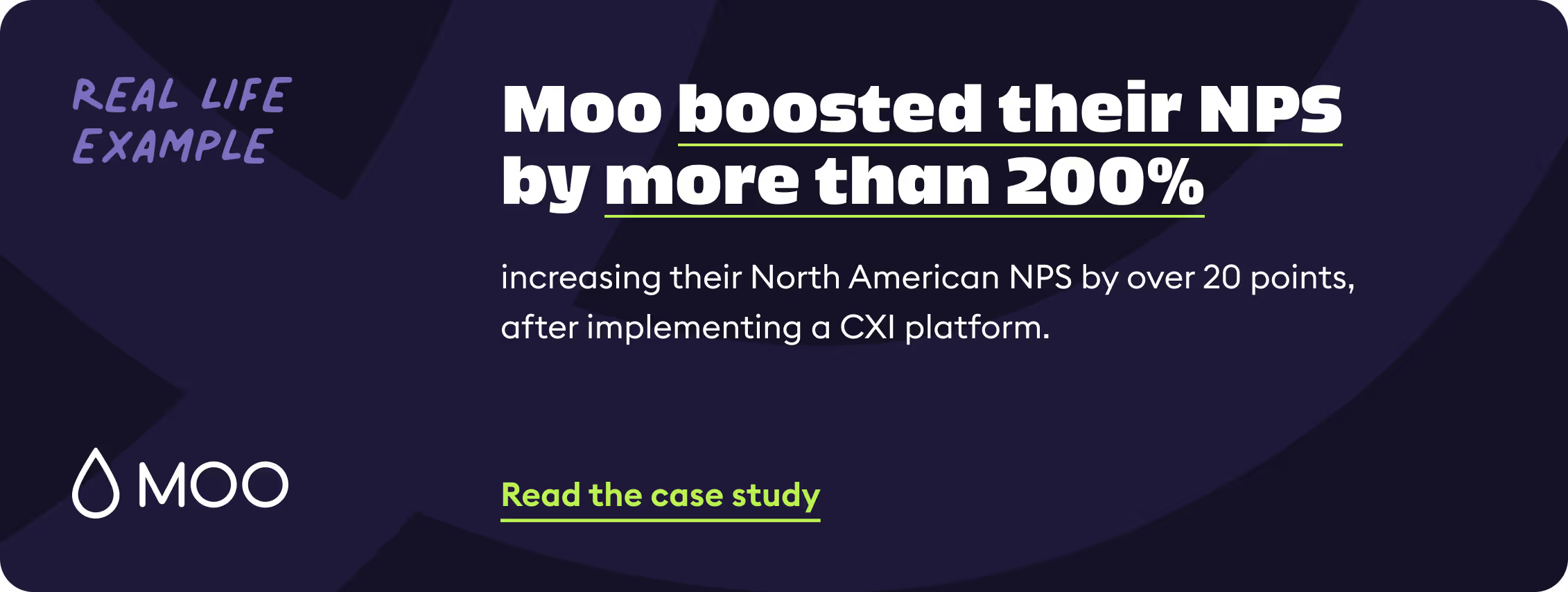
Product Returns Analysis
HOW IT WORKS
Anecdotal data alone won't prevent product returns. Businesses need concrete evidence to reduce the risk of refunds. A robust CXI platform helps by analyzing trends in return survey data, identifying key product issues driving high return rates, and enabling teams to take targeted actions to reduce returns.
QUESTIONS CXI CAN ANSWER
- What are the main reasons customers return products?
- Which specific products or categories have the highest return rates?
- What steps can we take to reduce return rates?
BEST FOR
Fashion, Sports, Homeware Retailers and E-Commerce

User Experience Analysis
HOW IT WORKS
Product teams often lack the capacity to analyze thousands of customer comments or have no access to company-wide insights. A CXI platform not only aggregates data from app reviews, NPS surveys, or customer support but also identifies key pain points across the user journey. This enables Product and UX teams to pinpoint reasons for low conversion or adoption rates and strategically inform the product roadmap.
QUESTIONS CXI CAN ANSWER
- What obstacles do users encounter during the checkout process?
- How well do the new features meet user expectations?
- What are the common challenges users face while using the product?
BEST FOR
Product Management, UX, Product Operations, Research Teams
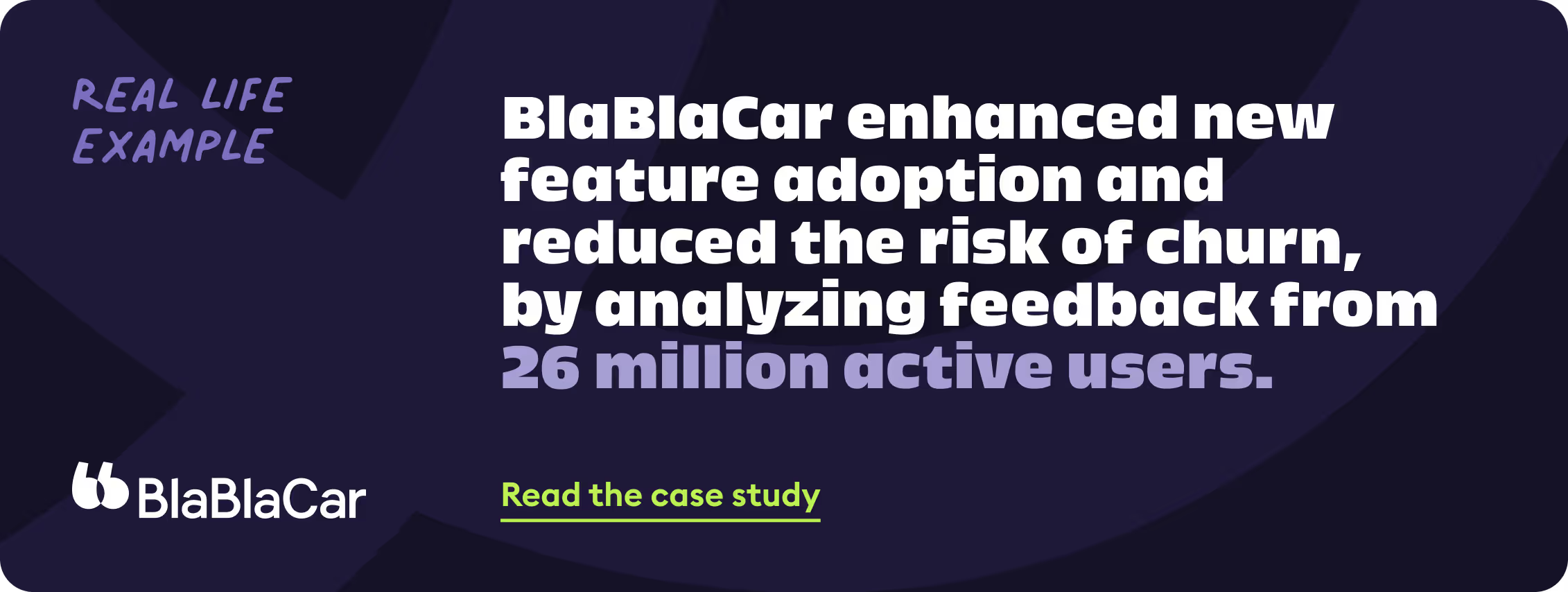
Retention Analysis
HOW IT WORKS
For businesses with thousands of customers, pinpointing the reasons for churn can be difficult - the details matter, and companies often respond when it's too late. Insights from a CXI platform platform can help reduce churn risk by identifying issues before they spiral out of control. By taking targeted actions, businesses can improve customer retention and boost overall customer lifetime value.
QUESTIONS CXI CAN ANSWER
- What factors lead customers to cancel their subscription?
- How do pricing and promotional offers influence customers' decisions to stay or leave?
- How do customers perceive us compared to competition?
BEST FOR
CX, Customer Insights, Product Teams, Revenue Teams
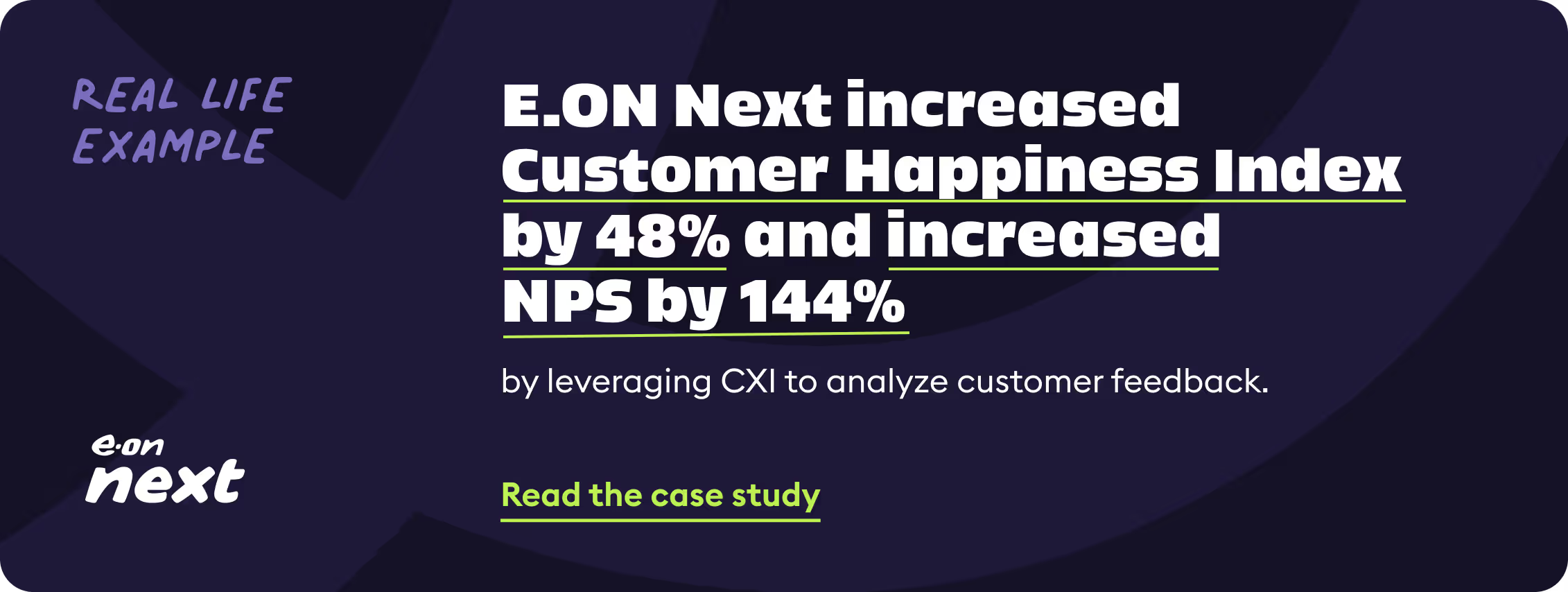
Share of Wallet Analysis
HOW IT WORKS
When teams lack insight into what motivates high-spending customers and how to attract more of them, a CXI platform can reveal important customer behaviour patterns. Customer insights can help identify the factors that drive repeat transactions among loyal customers, resulting in increased transactions per customer and higher revenue.
QUESTIONS CXI CAN ANSWER
- What motivates customers to make larger purchases?
- How can we encourage low-spending customers to increase their order frequency?
- What products do high-spending customers tend to purchase together?
BEST FOR
Fashion Retailers, Direct-to-Consumer Services

Product Inventory Analysis
HOW IT WORKS
When teams lack insight into what motivates high-spending customers and how to attract more of them, a CXI platform can reveal important customer behaviour patterns. Customer insights can help identify the factors that drive repeat transactions among loyal customers, resulting in increased transactions per customer and higher revenue.
QUESTIONS CXI CAN ANSWER
- What product issues do customers commonly report?
- Are there particular materials or styles that customers consistently praise or criticize?
- How does product quality influence repeat purchases and customer loyalty?
BEST FOR
Operations, Procurement, Merchandising, Marketing & Customer Support

Operations Analysis
HOW IT WORKS
Operations, Procurement, and Logistics teams often lack direct access to customers, leading to limited insights into their experiences. A CXI platform can pinpoint major customer concerns related to product quality, packaging, delivery, and logistics. By getting access to these insights, teams can enhance the last-mile experience, leading to improved operational efficiency, reduced costs, and fewer customer contacts.
QUESTIONS CXI CAN ANSWER
- What common delivery issues do customers report?
- Which carriers receive the most complaints?
- What feedback do customers have regarding packaging and sustainability?
BEST FOR
Operations, Logistics, Procurement, Quality Control Teams
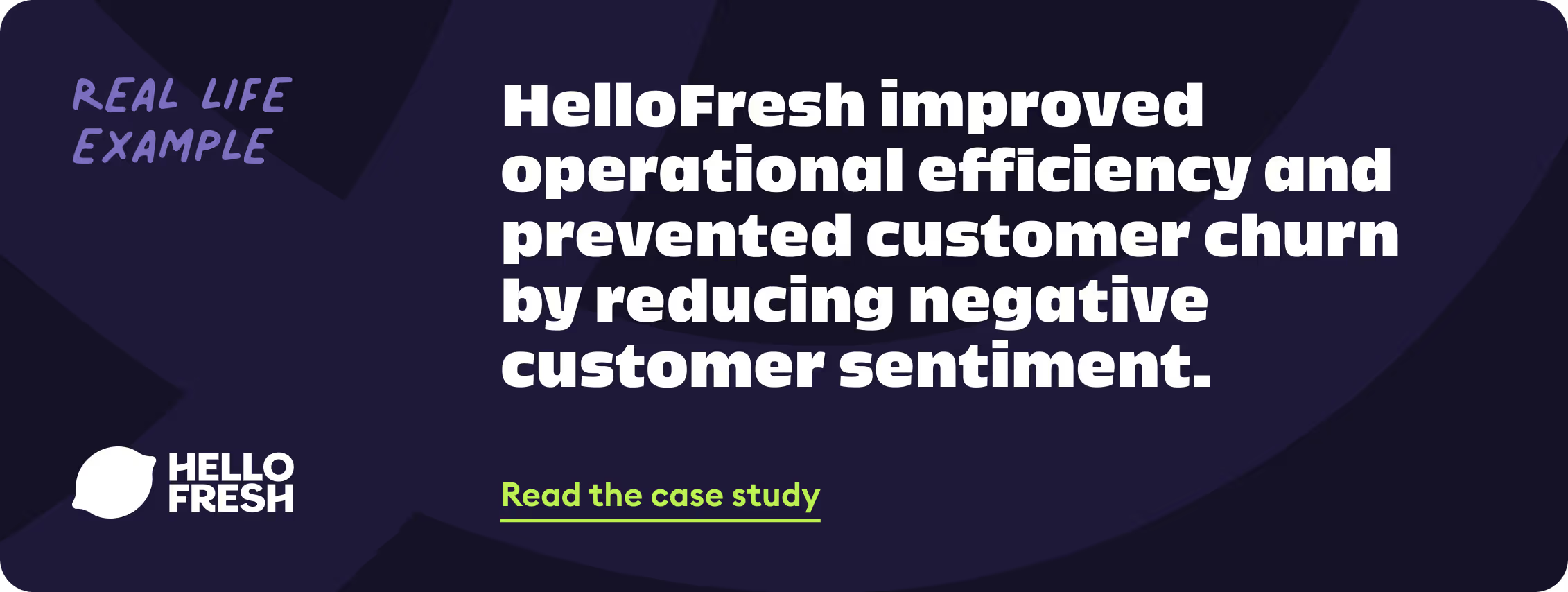
Support Contact Reasons Analysis
HOW IT WORKS
Customer emails, support calls, and chat conversations contain valuable insights but are often difficult to analyze at scale. A robust CXI solution automates the analysis of thousands of customer interactions, providing actionable insights that enable teams to reduce inquiry volume without dedicating hours to manual analysis.
QUESTIONS CXI CAN ANSWER
- What are the most common contact reasons?
- Which products or services generate the most inquiries?
- What recurring issues do customers face that could be addressed with a help guide?
BEST FOR
CX, Support, Insights, Product, Operations, Marketing Teams, Contact Centers

Competitor Analysis
HOW IT WORKS
Many companies tend to follow their competitors' lead in strategic business decisions without fully understanding what differentiates them in the market. A CXI platform can analyze publicly available data from app reviews and social media to identify gaps and key customer concerns about competitors' products. These insights can inform the creation of superior products and experiences, enabling your brand to stand out.
QUESTIONS CXI CAN ANSWER
- How do customers perceive the quality of competitors' products?
- How do competitors handle product returns and refunds?
- What innovative services do competitors offer that set them apart in the market?
BEST FOR
CX, Product, Marketing and Sales Teams
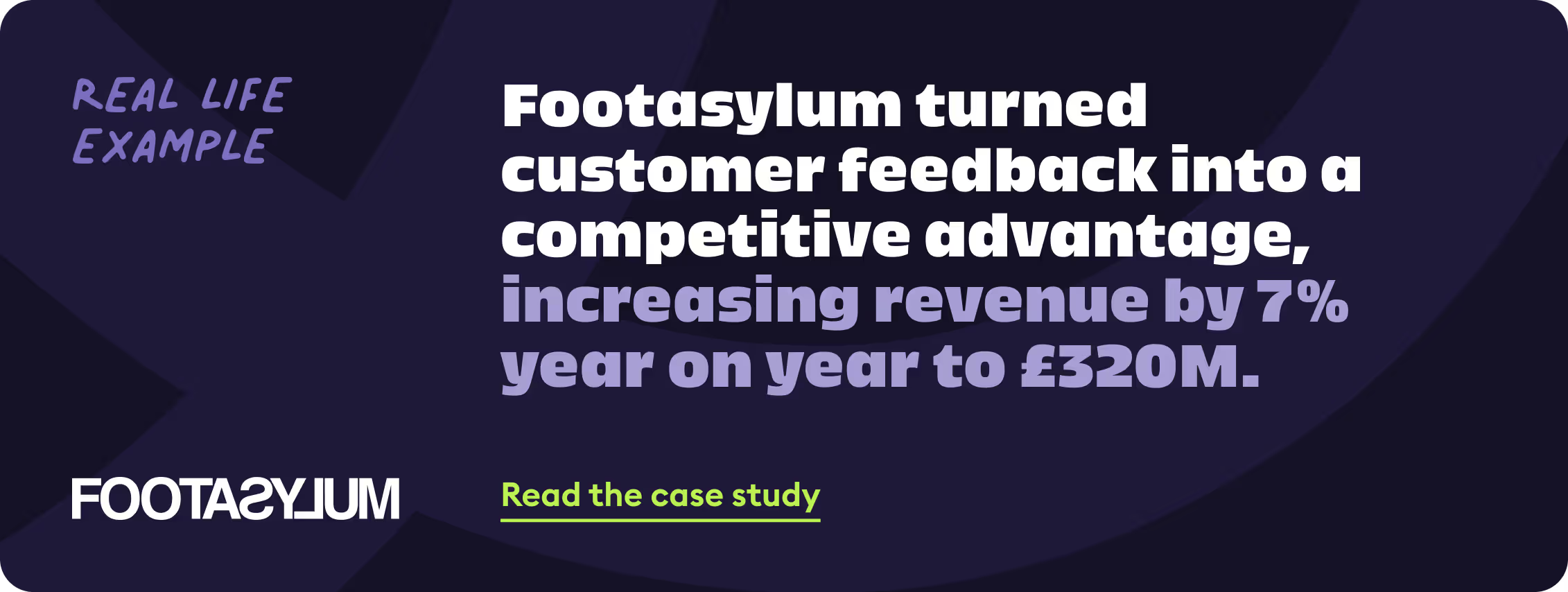
Why invest in CX Intelligence?
Many companies face operational challenges, such as manual processes or slow innovation, that often drive them to seek CXI solutions to automate the processes and do the heavy lifting.
For others, CXI platforms are vital for bringing teams together around a shared focus on customer experience, helping to create a customer-centric culture.
However, most businesses see CXI as a chance to gain a competitive edge. By truly understanding their customers and delivering outstanding experiences, they can stand out in the market.
In this section, we’ll highlight the key benefits of investing in Customer Experience Intelligence:
Save hours spent on manual analysis
Analyzing unfiltered and unstructured text feedback is crucial for understanding customer experiences, yet large volumes of data can overwhelm teams, paralyzing their ability to make strategic decisions.
The impact of CXI:
- Customer feedback is automatically analyzed in real-time, regardless of data volume, source, or language
- Improved speed to insights, eliminating inconsistencies and bias
- Operational costs decrease through the automation of manual tasks
- Time is saved, allowing focus on strategic CX initiatives
Enable teams to make informed decisions
Knowing what to prioritize, and which initiatives will deliver the highest ROI, is crucial to making effective investments. But without reliable data and actionable insights, teams are left flying blind, relying on intuition and assumptions to guide their decisions.
The impact of CXI:
- All data sources are centralized for a unified view across teams
- Teams can quickly uncover the drivers of business KPIs (NPS/CSAT)
- Key issues are prioritized with clear, actionable insights
- Decision-making is faster and grounded in solid data
Improve CX metrics and drive retention
CX metrics such as customer NPS, retention, or churn are often leading indicators of long-term business success and profitability, reflecting customer satisfaction and loyalty. Yet businesses struggle to connect key business metrics to their customer experiences, leaving them unaware of the true drivers behind their revenue and growth.
The impact of CXI:
- Understanding the drivers behind key metrics such as NPS and CSAT
- Uncovering factors and early signs of churn
- Pinpointing reasons for cancellations, refunds, or product returns
- Identifying opportunities to enhance LTV
- Improved customer satisfaction, loyalty, and retention
Become experience-led
To become an experience-led company, businesses must leverage their unique customer experiences as a key competitive advantage. This involves actively investing in and intentionally crafting a distinctive customer experience throughout the entire customer journey. Yet, without the appropriate tools to effectively identify and prioritize customer needs at scale, becoming experience-led is out of reach.
The impact of CXI:
- Offering actionable intelligence for both tactical and strategic decision-making
- Answering business questions across all teams and use cases
- Delivering insights that enhance conversions, enhance retention, and reduce operational costs
- Demonstrating that CX is a key driver of revenue for the business
Why is now the right time to invest in CXI?
You might be thinking, "Why is it necessary to invest in a CXI solution like this right now? Our current approach has been working just fine."
Although your team may be managing with existing manual processes, making strategic decisions without accurate and granular customer data puts businesses at significant risk. Companies risk allocating budget, time, and resources to the wrong investments while their competitors might celebrate another record-breaking year.
Truth is, in the era of economic turbulence, businesses can't afford to make poor investment decisions. To attract investors and stay afloat, they need to show solid unit economics. The best way to do this is by investing in a unique customer experience that drives higher customer lifetime value, ensuring the business thrives in the long run.

By now, you probably see why investing in a solution to improve customer experiences is so important and what you might miss out on by not doing so. In the next section, we’ll walk you through how to build a solid business case for a CXI solution that gets everyone in your organization on board.
Chapter 2: Creating a strong business case for CX Intelligence investment
Building a business case: step by step
Now that you’ve identified the need for a solution, it’s time to navigate the buying process. In this section, we’ll help you define the business outcomes that matter most, so you can clearly communicate the value to stakeholders.
Defining the business outcomes you’re looking to achieve is key. The clearer you are on what success looks like, the easier it is to assess which solution delivers the greatest impact for your organization.
Step 1: Identify key business outcomes
Start by defining which outcomes matter most to your business. Are there specific metrics your team is aiming to improve? Is there a company-wide initiative already in progress? What KPIs are you responsible for?
This step is important because while most companies recognize that customer experience impacts revenue, they often struggle to clearly link customer insights to measurable business results.

Here are the most common business outcomes companies aim to achieve by analyzing customer feedback:
Improve VoC metrics, such as NPS and CSAT
Investing in customer experience directly impacts your Voice of the Customer metrics - whether it’s NPS, CSAT, or CHI. With the right CXI platform in place, teams can understand what’s influencing these scores, spot areas for improvement, and take meaningful action.
The outcome: higher NPS and CSAT scores, lower churn, and increased revenue.
Retain your existing users, lower churn
Unclear why customers are leaving? Analyzing feedback helps you uncover what drives loyalty - and what pushes customers away. By segmenting responses, you can compare different cohorts and pinpoint what keeps them coming back.
The result: stronger retention, lower churn, and more loyal, satisfied customers.
Reduce the volume and costs of support contacts
High support volumes can overwhelm your resources. By analyzing the most common reasons customers reach out, you can identify key issues and optimize your processes. Automating the analysis of support emails, chats, and calls enables your team to address queries more efficiently.
The result: fewer support contacts and reduced operational costs.
Reduce product returns
Understanding the root causes of product returns - whether due to defects, unclear descriptions, or fit issues - helps you tackle problems early. CXI platforms give your team the insights needed to reduce return rates and resolve pain points effectively.
The result: fewer returns, happier customers, improved loyalty that drives sustained business success.
Increase LTV and the number of transactions per customer
Do your teams lack clarity on what motivates your most loyal, high-spend customers? Analyzing customer feedback reveals what keeps them coming back - and how to attract more like them. With these insights, you can double down on what works.
The result: higher retention, increased customer lifetime value, and more transactions per customer.
Boost conversion rates on your website or app
Use CXI to identify where users struggle across your website and apps to improve conversion rates. By analyzing user experience, user experience and customer contacts, you can pinpoint friction points that hinder sales and satisfaction.
The result: smoother user experiences, improved conversion and increased sales.
Step 2: Identify the pain
Once you've identified 2–3 key business outcomes to focus on, the next step is to define the specific challenges behind each one. Ask yourself: What pain points are teams facing today? Can you pinpoint a concrete problem you'd like to solve?
For instance, if you're working at a retail fashion brand and product returns have increased over the past year, start by quantifying the issue.
- How many orders were placed last year?
- What percentage were returned?
- What’s the cost per return?
The more specific you are, with real figures where possible, the easier it will be to assess impact and prioritize solutions.


Step 3: Quantify the business impactof that challenge
Once you've outlined your key challenges and defined your target outcomes, the next step is to turn the pain into measurable financial impact. Start with your baseline, then model the value of improvement.
Take the example of a retail fashion brand struggling with high return volumes. By collecting data like total order volume, return rate, and average cost per return, you can estimate the annual cost of returns. This gives you a concrete way to highlight the scale of the problem - and a compelling case to share with leadership.
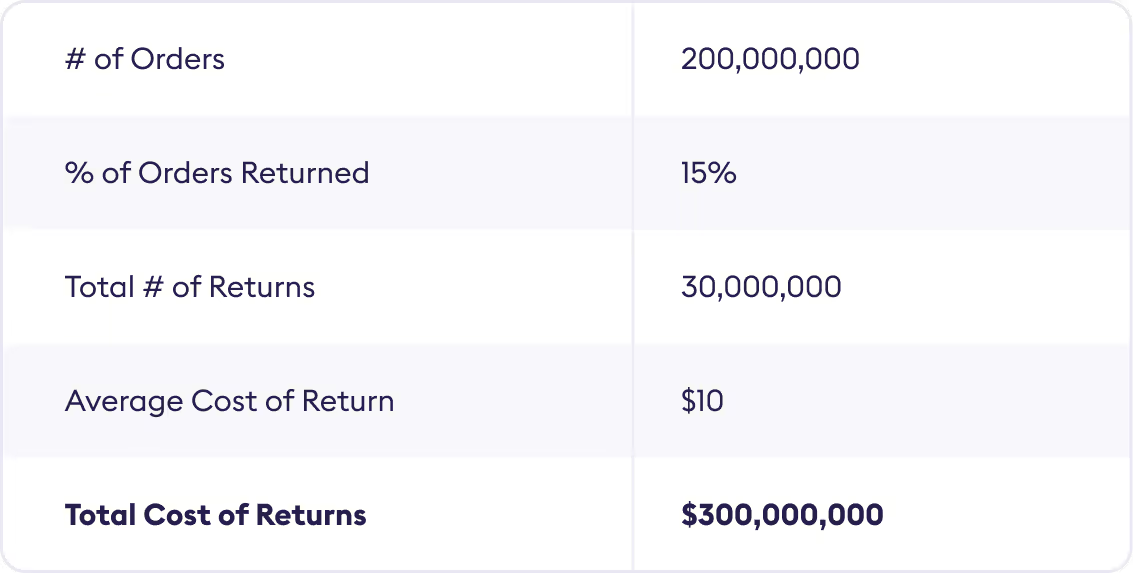
A 5% relative reduction in return count = $15M in annual savings.
Step 4: Quantify the ROI & payback
Once you know the potential impact, connect it to investment costs to show ROI.
Example metrics to calculate:
- Gross Savings = Baseline cost − Cost after improvements
- Net Savings = Gross Savings − Investment
- ROI % = Net Savings ÷ Investment
- Payback (months) = Investment ÷ (Gross Savings ÷ 12)
- $ Saved per $ Spent = Gross Savings ÷ Investment

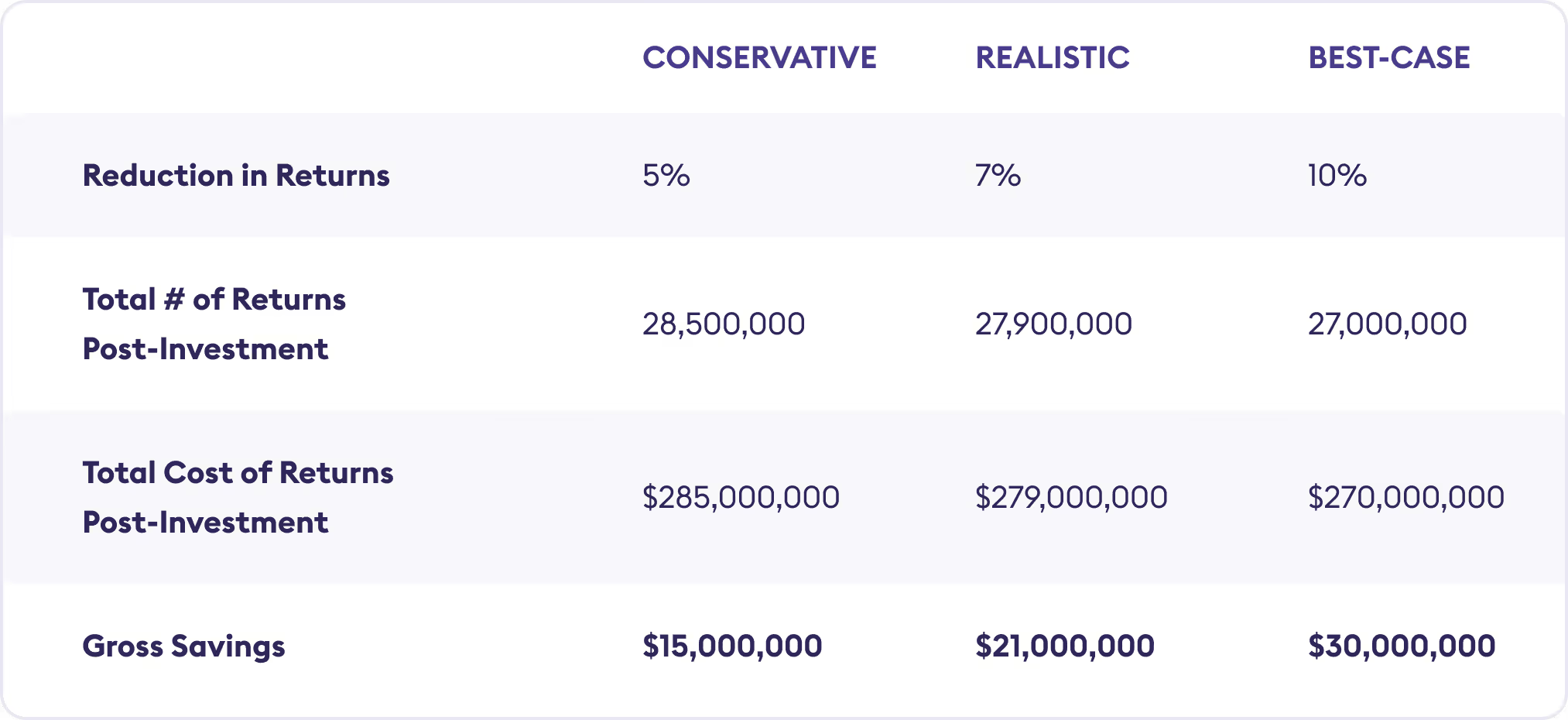
Looking for examples?
Chattermill has created ready-to-use financial models to help you demonstrate ROI with ease:
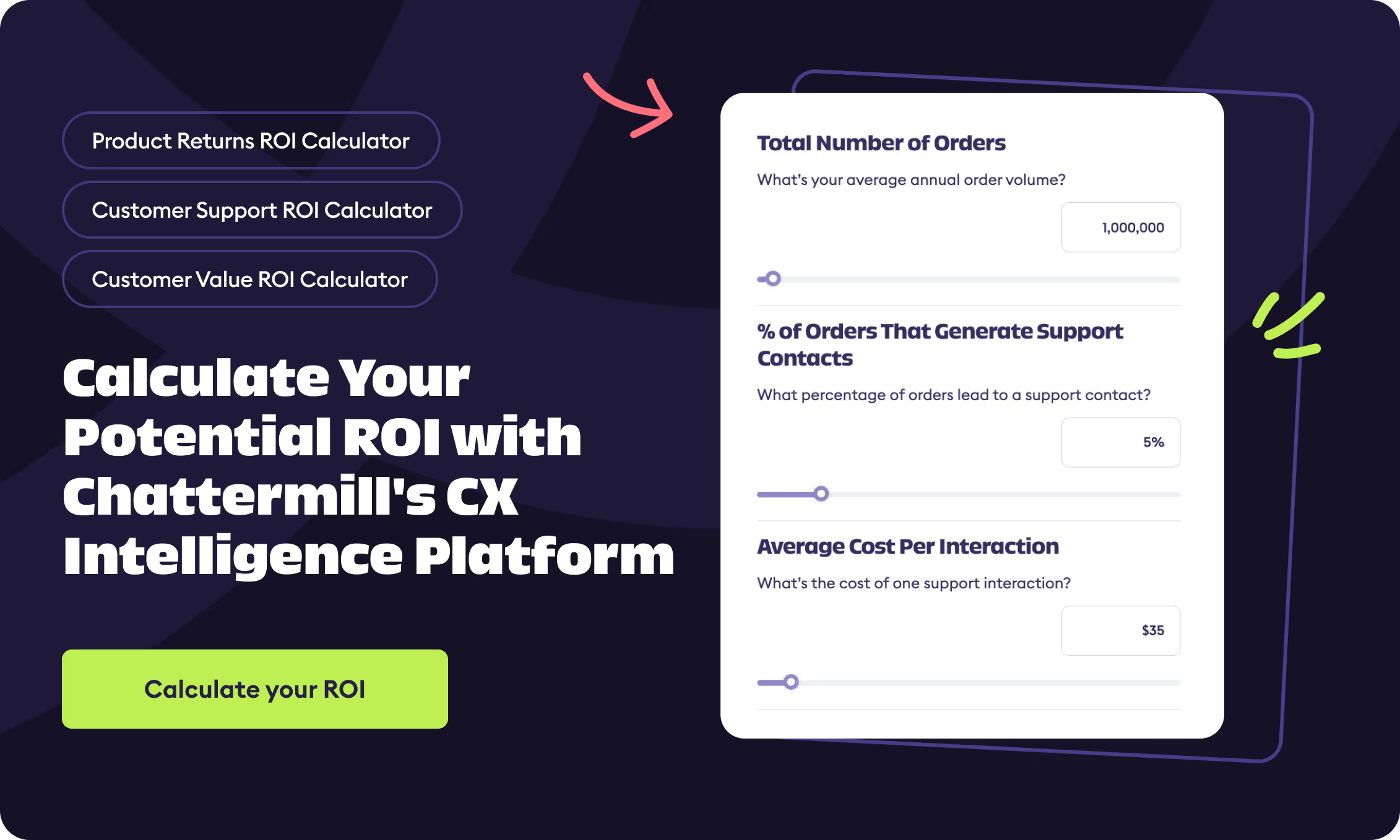
Step 5: Document assumptions
A business case is only as strong as its assumptions - the foundation your calculations depend on, like "returns cost $10 each." If any assumption is off, your ROI changes. By listing them clearly, you help leadership understand which numbers are solid versus which could shift, so they can make informed decisions.
Example assumptions to list:
- Baseline window: e.g. “We analyzed 12 months of returns from Jan-Dec 2024.”
- Data coverage: e.g. “We tracked ≥ 90-95% of all product returns.”
- Model accuracy: e.g. "Our system correctly identifies return reasons at least 90% of the time."
- Policy stability: "No changes to return policy, pricing, or shipping speeds during the test period."
- Attribution rules: e.g. "Savings begin counting after a 30-day delay to account for the return cycle."
Template: Make the case for investment
Use this template to outline the outcomes your business wants to achieve with a Customer Experience Intelligence Solution. It will help you connect key challenges to measurable impact and build a compelling business case to move forward.





Baseline: Last 12 months (seasonality-adjusted)
- Data coverage: ≥ 95%
- Model accuracy: ≥ 90%
- Attribution rule: First shipped fix, 30-day lag
- Confidence: Returns = High, Retention = Medium
Chapter 3: The CX Intelligence category and market
As the AI landscape continues to evolve, so do the ways businesses can turn customer feedback into actionable insights. To close the data gaps in customer feedback analysis, vendors have taken a variety of approaches - each with its own strengths, limitations, and ideal use cases.
The four most common approaches businesses consider are:
- Enterprise Experience Management
- Customer Feedback Analytics
- Customer Experience Intelligence
- Generative AI Solutions
At first glance, these categories may seem interchangeable, and it’s true that there can be overlapping features across solutions.
However, there are key differences in how each one captures, analyzes, and operationalizes feedback. Understanding these differences will help you determine which approach is best suited to your organization’s needs and objectives.
Experience Management Platforms
Example solutions: Medallia, Qualtrics, InMoment
Best suited for: Large enterprises looking for an all-in-one platform that combines survey collection, analytics, and the ability to scale.
Customer Experience Management (CXM) solutions are built for large enterprises that want an all-in-one platform for survey creation, distribution, data collection, and analysis. These platforms offer highly customizable survey tools and support the full end-to-end process - from designing and sending surveys to analyzing results.
While the appeal of an all-in-one system is strong, it often comes with trade-offs: high costs, complex onboarding, limited flexibility, and a steep learning curve.
In addition, many CXM providers excel at data collection but fall short on the analytics side. Their reliance on rule-based AI can result in insights that miss nuance and subtle signals, and lack actionable intelligence - especially compared to more advanced, modern AI models.
In addition, a common limitation of some CXM analytics is that they can only handle one data source at a time - meaning different data points, such as NPS and CSAT, are analyzed in isolation, making it difficult to get a unified view of the customer experience.
If your main priority is collecting structured feedback at scale, analytics is a secondary concern, and you have a sizable budget, a CXM solution could be a suitable fit. But if you're seeking a solution that excels at turning unstructured data into clear, actionable insights, you may want to explore more specialized analytics tools.
Customer Feedback Analytics Tools
Example solutions: Thematic, Enterpret, UnWrap
Best suited for: Mid-market companies seeking a point solution, designed to solve one specific problem or use case.
A typical Customer Feedback Analytics platform is often a point solution, built to address one specific problem or use case within a business. It focuses narrowly on a single function - such as product feedback analysis or customer experience analysis - delivering specialized insights for that area.
Although these tools might provide strong, targeted results within their specific areas, they often fall short when companies need to scale customer feedback insights across broader organizations - spanning multiple teams and varied use cases.
Businesses looking to democratize customer insights across the entire organization, solve company-wide challenges, and deliver impactful business outcomes, will need more than a point solution. They’ll need more robust analytics that allow to incorporate not only multiple data sources but complex metadata and data enrichments, allowing for comparisons of different data types or including competitive benchmarks.
If your team is leaning toward a point solution, take a moment to check in with key stakeholders about how well it will serve the whole company. You want to avoid investing in a tool that fits only a small part of your needs and ends up being replaced soon after.
Instead, aim for a solution that can scale with your business and deliver valuable customer insights across teams - like CX, Support, Product, Marketing, and Revenue - helping everyone make smarter, data-driven decisions.
Customer Experience Intelligence Platforms
Example solutions: Chattermill
Best suited for: Enterprise companies that see CX as a key growth driver - and need actionable and reliable insights that connect CX performance to their key business results.
Customer Experience Intelligence solutions bring together the intuitive design of point solutions with the power and scale of enterprise-grade platforms.
Here’s what sets strong Customer Experience Intelligence platforms apart:
CXI analyzes the voice of the customer in your business context
A CX Intelligence platform goes beyond basic dashboards or survey analytics. It helps you understand customer feedback in the full context of your business - so you can make decisions based on a complete picture, not isolated data points.
What does that mean in practice?
- You get a complete, unified view of customer feedback - so nothing is missed or trapped in silos. With all your feedback in one place, whether it comes from surveys, reviews, support tickets, chat logs, calls, or social media, you can spot patterns across the entire customer journey.
- It becomes part of your workflow, not another system to manage. That’s because it fits into your existing data infrastructure - whether that’s APIs, warehouses, or data lakes - so you avoid duplicating effort or reworking internal processes.
- Each piece of feedback can be enriched with relevant business context - like customer ID, country, product, or transactional details - which means you can segment the data in a way that reflects how your business actually runs, and tie insights directly to business outcomes.
CXI platforms deliver both: strategic and precision insights
A CX intelligence platform delivers two types of insights that together give your business a better understanding of customer feedback:
- Strategic insights help you see the big picture. They reveal overarching trends, shifting customer needs, and emerging opportunities. This informs longer-term decisions like product roadmaps, market positioning, and overall strategy.
- Precision insights provide detailed, actionable information. They highlight specific issues or sudden changes - such as a recurring complaint about a product feature or a drop in satisfaction within a customer segment—enabling teams to respond quickly and effectively.
This combination helps leaders and teams prioritize efforts, reduce guesswork, and target resources where they will have the most impact.
CXI platforms deliver outcomes for every team
Insights are only valuable when translated into action. A CX Intelligence platform enables every team to convert insights into concrete decisions that drive measurable results throughout the organization.
This is important because data alone does not drive change. Achieving successful outcomes requires teams to take ownership, integrate insights into their workflows, and clearly demonstrate the impact of their actions.
What does that mean in practice?
- A strong CXI platform provides intuitive tools to help your teams answer any business question. Whether it’s Product, Support, Marketing, or Revenue teams - everyone should have access to insights that help them make smarter decisions.
- Insights are tailored to your specific business needs, making it easier for your teams to focus on the most important issues and opportunities.
- A CXI platform provider offers ongoing expert support to help embed insights into daily workflows, ensuring teams take action and connect results directly to business goals.
CX Intelligence platforms do more than reveal what customers say - they provide insight into why it matters, the context behind the feedback, and the next steps to take. It’s not simply another dashboard - it’s a system built to connect customer input with actionable outcomes and measurable business results.
Generative AI Solutions
Example solutions: ChatGPT, Gemini, Claude, Microsoft Copilot
Best suited for: Companies with small datasets, single data sources and single use cases, looking for fast, flexible ways to generate insights.
Generative AI tools offer a range of capabilities for summarizing and interpreting text-based data - including customer feedback. They might help teams accelerate feedback analysis, summarize key insights, or draft reports, making them valuable for quick, targeted tasks. It can be tempting to rely on Gen AI tools for exploring insights without complex queries, but there are some important pitfalls to be aware of.
First of all, generative AI lacks precise control over sentiment analysis and theme detection. This can lead to mixed or ambiguous sentiments and diluted theme accuracy due to the inclusion of unrelated information. They may also overlook industry-specific nuances, offering less contextual depth compared to specialized feedback analytics platforms.
Secondly, because GPT models rely on probabilistic sampling, they may produce different outputs from the same input (known as hallucinations), which limits consistency in feedback summaries leading to inaccurate insights. Even with prompt engineering, the generated output can be unpredictable and may not always perfectly align with specific business contexts or customization needs.
Furthermore, because they rely heavily on patterns in training data, they can unintentionally reproduce biases or miss emerging trends unique to your data.
All of these factors mean that while Gen AI can speed up exploratory feedback analysis, it should be used cautiously and always alongside human expertise and more robust, specialized analytics tools.
Chapter 4: Feature function evaluation guide
Whether you’re exploring a Customer Experience Management solution, Customer Feedback Analytics tool, or a Customer Experience Intelligence platform, it can be challenging to determine if the option you choose truly fits your needs. Since partnering with a vendor is often a long-term commitment - and switching later can be costly and complicated - it’s important to approach this decision carefully.
To increase your chances of finding the best fit, we recommend creating an evaluation matrix that outlines key criteria and lets you score vendors systematically during your review.
We’ve put together a general overview of feature capabilities to guide you during your evaluation. For a more detailed list, Chattermill can provide an RFP template to help you build your own comprehensive evaluation checklist.
Our evaluation is divided into four key sections, each with a useful checklist:
- Feedback unification capabilities
- AI capabilities
- Reporting capabilities
- Collaboration & sharing capabilities
- Enterprise readiness

Feedback unification capabilities
The first thing to evaluate in a potential vendor is the type of data they can integrate and how that integration works. To get meaningful insights, you need to bring together feedback from all your channels - surveys, reviews, support tickets, and more - into one place. A platform that unifies this data into a single source of truth lays the foundation for reliable and effective customer feedback analysis.
When evaluating potential providers, focus on these key aspects:
Integrations with multiple feedback sources
Check which feedback sources your potential solution supports, such as surveys, support tickets, online reviews, and internal data (CRM, CSV files). You may start with a few key channels, but ensure the vendor can add more complex sources later, like social media or call recordings, to avoid costly switches down the line. When evaluating a provider, look for one that allows customization of pre-built integrations - ideally, they should let you map and filter the data to fit your workflows.
Coverage for multiple languages
Check how the provider handles multiple languages. If you plan to expand globally, you need accurate translation and analysis for all languages.
API
If you collect feedback using internal tools or plan to import it from a central data warehouse, check that your provider includes API access in your package and offers clear API documentation. It allows you to automatically send feedback into the platform and push insights back into your internal systems.
Data unification
Data unification means more than just connecting multiple feedback channels - it’s about combining all that data into a single, clear project or dashboard. To truly understand the full customer journey, you need one unified view, not separate snapshots of individual touchpoints.
Metadata enrichment
Metadata enrichment means adding extra details to your feedback, like customer ID, transactional data, or location, so you can slice and dice feedback to get more meaningful insights. This helps you filter and compare data more effectively, making it easier to answer complex questions.
Noise removal
Ensure your solution can filter out irrelevant or low-value data - such as greetings and unrelated chatter - and eliminate duplicate entries to keep results accurate.
PII anonymization
Always consider how vendors handle personally identifiable information (PII). Ensure that sensitive data, like phone numbers or credit card details, is anonymized or removed when necessary.


AI capabilities
AI analytics lie at the core of every solution in this category. However, not all AI approaches deliver truly actionable insights. Make sure your chosen platform uses cutting-edge AI models to provide accurate, reliable, and consistent results. These insights should be detailed enough to help you confidently prioritize the most important strategic and tactical initiatives.
When evaluating potential providers, focus on these key aspects:
Taxonomy
A taxonomy is a system that organizes customer feedback into categories and themes. Since every business is unique, a generic taxonomy provides limited value. Choose a platform that customizes analysis for your specific datasets, tagging feedback with themes relevant to your products and services - not just broad industry terms.
Achieving the right level of detail
A good taxonomy balances precision and clarity. Too much detail can obscure broader trends. The best solutions offer multiple levels of granularity - from broad categories to specific themes - letting you move easily between high-level overviews and detailed insights.
Conceptual themes
Choose tools that offer conceptual themes rather than just keywords or mentions. While keywords track how often terms like “bug” appear, conceptual themes group related feedback to highlight the underlying issues - such as “app reliability problems.” It provides more context and an accurate understanding of customer feedback.
Taxonomy management
Look for a solution that lets you edit the taxonomy and manage themes as your priorities evolve. Your team should be able to add or adjust themes when needed - without opening it up to too many users, which could affect consistency or lead to unreliable results.
Complete data coverage
Choose a solution that allows you to tag as close to 100% of your data as possible, ensuring there is not a single piece of customer feedback that remains ignored.
Emerging concepts
Look for a solution that gives you the flexibility to track the themes that matter most to you. To do this, it should tag 100% of your data without missing any feedback, as well as surfacing organically occurring topics that may warrant the creation of a new theme to track, and also let users choose which themes to focus on, create new themes, and edit tagging flexibly.
Aspect-Based Sentiment Analysis
Choose a solution that uses Aspect-Based Sentiment Analysis (ABSA), which can detect multiple themes in a single comment and assign sentiment to each one individually. For instance, if a customer praises delivery speed but complains about product quality, the tool should capture both sentiments separately and accurately. Steer clear of solutions that rely on manual tagging or researcher interpretation, as this introduces subjectivity - ultimately reducing the reliability of your insights.
Robustness over time
As your business evolves, choose a solution with pre-trained, self-supervised models that scale with growing data - without constant manual rule updates. This helps maintain accurate, reliable insights over time.
Gen AI capabilities
Choose a solution that uses Gen AI to summarize feedback and help users quickly find insights - but make sure it also minimizes the risk of hallucinations and provides quantified insights, so you can clearly understand the size and severity of each issue.
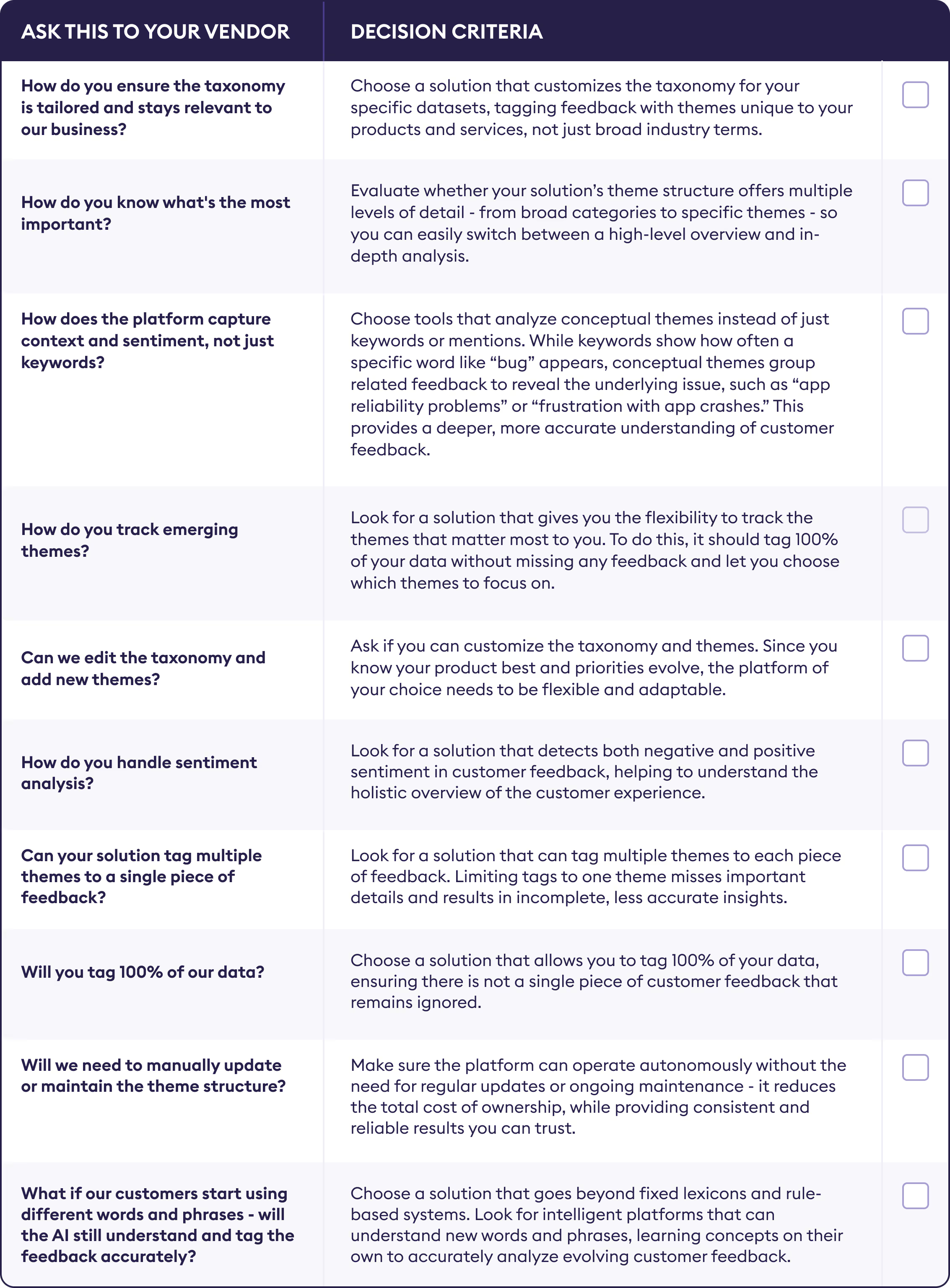
Reporting capabilities
Robust reporting turns feedback into action. Your solution should help teams track trends, pinpoint root causes, and monitor key metrics, while staying easy to use so anyone can explore data and answer business questions with confidence.
When evaluating potential providers, focus on these key features and capabilities:
Metrics
Ensure the platform supports a wide range of metrics - NPS, CSAT, net sentiment, sentiment distribution, positivity, and negativity indexes - and allows you to include your own internal business metrics. The tool should help you track metric trends, identify what’s driving changes, and uncover the root causes of customer dissatisfaction.
Filters & segments
Look for a solution that lets you filter, segment, and enrich data with multiple layers of breakdowns to build tailored reports answering specific business questions. Make sure the provider supports metadata inclusion and offers a user-friendly interface for easy analysis using these data dimensions.
Comparisons
Look for a solution that allows you to compare data across user segments, geographic locations, or time periods to quickly analyze performance across different markets or customer groups.
Historical tracking
Ensure the vendor retains historical data for a significant period and supports time-series analysis to track changes over time and enable benchmarking against past periods.
Use cases supported
Ensure your vendor offers the expertise and product capabilities needed to support key use cases such as NPS analysis, product returns, retention, product feedback, and share of wallet. This should include custom dashboards, reports, and alerts tailored to each use case.
Impact analysis
Metrics often guide decisions, but it’s much more valuable to identify what truly impacts score changes and uncover the root causes. Choose a solution that shows how different themes impact your key metrics so your team can prioritize initiatives that deliver the best results.
Precision insights
Choose a solution that provides a clear list of your biggest customer issues - quantified by volume and impact. It should offer granular, actionable insights that let you prioritize what to address next without needing to analyze feedback manually.
Verbatim feedback
Make sure the solution supports each insight with direct customer quotes. These snippets give context, build trust in the data, and help others understand the real customer experience behind the numbers.
Summaries
Most AI solutions offer quick GPT-powered summaries to condense long customer threads and key data points. Choose a solution that delivers accurate summaries without hallucinations, correctly quantifies response volumes, and includes supporting quotes for every highlight.
Dashboards
Choose user-friendly, customizable dashboards that show key metrics and their drivers. Look for features like filters, time ranges, comparisons, annotations, and GPT summaries to help teams easily access relevant insights.
Ease of use & intutive UI
Choose a solution that’s intuitive and easy for everyone in your organization to use. Make sure creating and managing reports or dashboards, adding widgets, and filtering data are simple. Features like templates and quick summaries are especially helpful for beginners.

Collaboration & sharing capabilities
You’ve analyzed your feedback and want to share the results with product teams and stakeholders. Choose a solution that makes collaboration easy, democratizes insights, and lets everyone access and explore data independently.
When evaluating potential providers, focus on these key features and capabilities:
Workflows
Look for a solution that makes it easy to keep your team updated. Can you automatically send reports to the right people via email or Slack? Does the tool notify you about shifts in themes, new topics, or unusual trends? These features help your team stay informed and act quickly.
Report sharing
If you collaborate with external partners, choose a solution that lets you share specific reports or dashboards securely - without giving full access to the platform. This keeps your data protected while keeping partners in the loop.
Issue tracking integrations
If you work closely with Engineering, look for a solution that can automatically create tasks or tickets when critical bugs or product issues are flagged in customer feedback - this helps ensure nothing falls through the cracks.
Data exports
Ensure the solution lets you export analyzed data in formats like CSV or PDF, or access it via API - so you can combine insights with your internal data and systems.
Alerting
Look for a solution that can trigger alerts when anomalies or sudden changes in your data are detected. It’s especially useful if different teams can get notified about shifts in key themes or metrics relevant to them.
Adding new users
If more teams, like Product or Marketing, might use the platform in the future, choose a vendor that doesn’t charge per seat. This way, you can give more stakeholders access without worrying about extra costs.
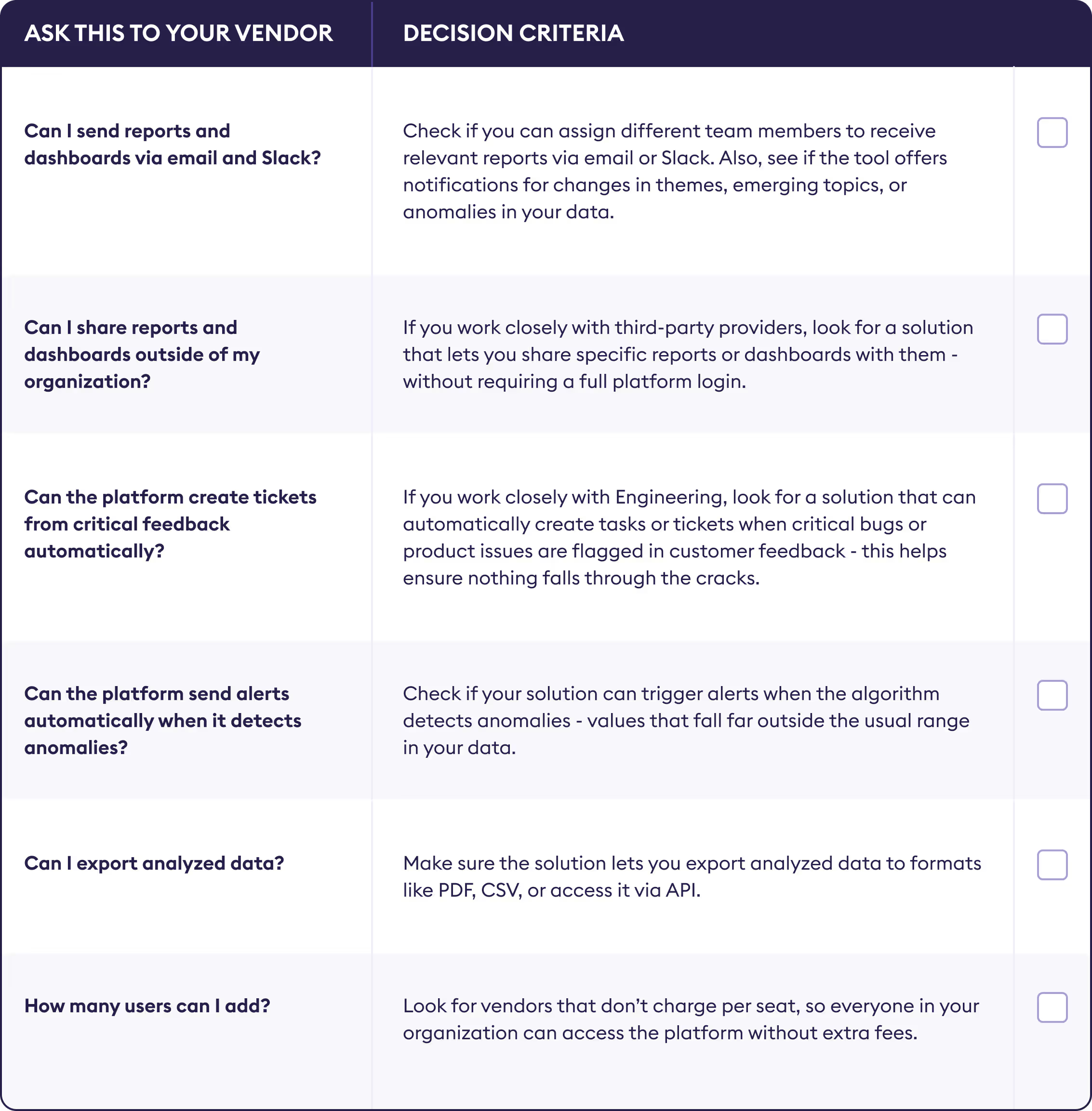
Enterprise readiness
If you’re trusting a third-party provider with your customer data, it’s essential to ensure they meet your legal and security requirements. The platform should follow strict data protection practices and comply with the highest privacy standards.
Look for providers that offer:
- Single Sign-On (SSO)
- Two-Factor Authentication
- PII Redaction
- GDPR Compliance
- Security Certifications (e.g. SOC 2 Type II, ISO 27001)
- User Roles & Data Permissions
- AI Policy

Chapter 5: Operationalization
Insights come first, but real impact comes from taking action.
Even after defining your key business outcomes during the ROI process, it’s often unclear how to translate those goals into actionable steps within your platform.
Teams frequently struggle with deciding which data sources to connect, how to ensure feedback quality, what dashboards to build, how to uncover meaningful insights, and who should be involved in making decisions. Without clear direction, moving from goals to practical actions can feel overwhelming.
Technology alone won’t deliver results. Real success comes from combining powerful tools with expert guidance.
To truly enhance customer experience, companies need more than just software - they need a partner who connects insights directly to business outcomes. The best providers offer advanced technology alongside strategic support to help drive Experience-Led Growth across the organization.
Here’s what you should keep in mind when seeking a strategic partnership focused on driving meaningful business outcomes.
Vendor evaluation guide
Technical onboarding
Onboarding
Find out how quickly your team can get up and running - and how long it takes to fully set up and configure the platform.
Why does this matter?
A smooth, fast onboarding means your team starts benefiting from the platform sooner, reducing downtime and speeding up time to value. Delays in setup can slow progress and impact your overall program success.
How to spot the right partner?
Choose a vendor with a proven onboarding process that gets your team up and running within weeks - not months. They should provide clear timelines, a dedicated onboarding specialist, and thorough training to ensure quick and effective platform adoption.
Program design
CX maturity assessment
Ask if your vendor can help assess where you are in your CX journey and identify your biggest gaps and opportunities for improvement.
Why does this matter?
Because there’s no one-size-fits-all approach. Companies are at very different stages in their CX journey. Some are just beginning to build their VOC programs, while others have mature CX strategies in place and are now focused on optimization and long-term growth.
Achieving Experience-Led Growth starts with understanding where you are today - and that requires a partner who can accurately assess your CX maturity.
How to spot the right partner?
Choose a vendor that can conduct a comprehensive CX maturity assessment and provide a detailed report outlining your current strengths, weaknesses, and any barriers to progress. They should also help you define customized KPIs that are directly tied to your core business metrics and develop a clear, tailored roadmap to help you move forward with confidence.
Data collection strategy
Find out if the vendor can support you in evaluating and improving your data collection strategy when needed. This includes helping ensure you’re gathering the right data at the right time, so your insights are accurate and actionable from the start.
Why does this matter?
Getting your data collection right is essential if you want your insights to deliver real value. It’s not just about gathering feedback - it’s about collecting the right data at the right moment through the right channels.
For example, if you want to understand the checkout experience but only ask for feedback days after delivery, you’ll miss critical insights. Similarly, if you over-focus on one touchpoint but try to draw conclusions about the full customer journey, your decisions will be based on incomplete - or skewed - information.
These two factors - timing and data coverage - are critical to getting meaningful, reliable insights.
How to spot the right partner?
Choose a provider who truly understands your feedback challenges and can help improve your data collection process. They should be able to conduct touchpoint gaps analysis, assist in designing effective surveys, and ensure the data you gather is accurate, comprehensive, and aligned with your key business goals.
Implementation & go-live
Use case operationalization framework
Check if the vendor provides a clear framework to help you operationalize your use cases - both in the platform and across your organization.
Why does this matter?
Setting business goals and KPIs is a strong start - but without a clear path to action, even the best strategies stall.
Many organizations define their desired outcomes, estimate ROI, and select a platform - only to struggle when it’s time to implement. Which data sources should you connect? How do you ensure the data is clean and reliable? What reports and dashboards will actually drive decisions?
How to spot the right partner?
Look for a partner who can turn your strategy into a clear, actionable plan tailored to your organization. They should start by aligning on your business goals and helping you prioritize the most valuable use cases.
A strong partner will:
- Identify the most relevant data sources to integrate
- Ensure accurate feedback data analysis
- Share best practices for sharing insights across teams
- Help drive action
Also, choose a partner that offers a range of expert resources, including 1:1 consultations, in-person deep dives or team workshops designed to help you get the most from your program.
Architecture design
Ask if the vendor provides hands-on support to help you design dashboards, reports, and alerts tailored to your specific use cases.
Why does this matter?
Tailored dashboards and reports ensure users see the most relevant data and insights for their specific use case - whether that’s product returns, customer retention, or NPS trends. This focused view helps them answer key business questions accurately and take effective action based on precise insights.
How to spot the right partner?
To spot the right partner, make sure they offer hands-on help customizing dashboards, adding relevant metadata, setting up the right segments and filters, and tailoring reports and alerts to fit every team and use case - so insights are clear, actionable, and truly useful across your organization.
Bespoke reporting
Find out if your vendor has a dedicated insights team that can dive into your data periodically and deliver tailored reporting when needed.
Why does this matter?
An external insights team brings fresh perspectives and advanced expertise to uncover hidden opportunities or risks that your teams might overlook. This helps ensure you’re not missing critical insights that could impact your business decisions.
How to spot the right partner?
Look for a vendor with a dedicated insights team that offers tailored, deep-dive analyses on demand - helping you uncover hidden trends, risks, and opportunities beyond what your internal team can spot.
Ongoing customer support
Ask what resources are available when you need platform support or technical assistance.
Why does this matter?
You want to ensure you have access to the right resources whenever you need help - whether it’s technical support, platform training, or consulting expertise.
How to spot the right partner?
Look for a provider that assigns a dedicated Customer Success Manager who understands your goals and acts as a strategic advisor - offering best practices, industry insights, and proactive recommendations. You should also have access to technical experts who can support custom integrations, AI model understanding, or taxonomy management.
Training & certification
Ask if the vendor offers on-demand training and certification for your teams, so everyone can confidently learn how to use the platform.
Why does this matter?
Customer experience intelligence only delivers value when everyone in the organization can access it and work toward shared goals. Yet, CX teams often lack the time and resources to train other departments, which can limit adoption and impact.
How to spot the right partner?
Choose a provider that offers a mix of in-person training, on-demand courses, and certification programs to support self-paced learning. This approach helps drive adoption across teams, empowering all users to confidently leverage the platform and ensuring sustainable, long-term success.

About Chattermill
Chattermill, the Customer Experience Intelligence company, enables leading brands to unlock their customers' reality. Global enterprises like Amazon, H&M, and Uber rely on Chattermill to operationalize CX data. Chattermill is the best-in-class AI-powered platform for CX, Product, Marketing, and Support teams to action insights from their customer data at scale, ranked no.1 in multiple G2 categories.
